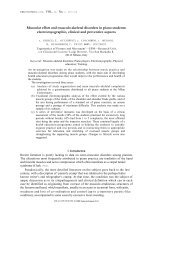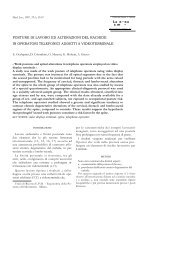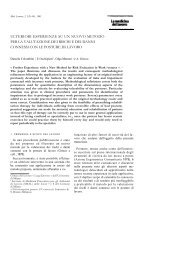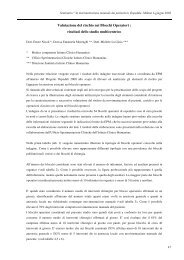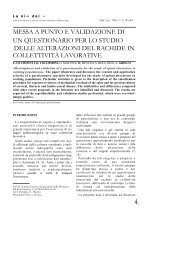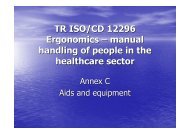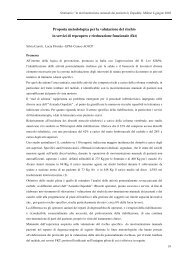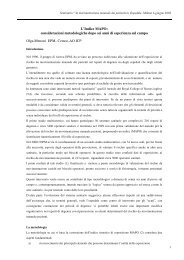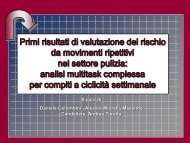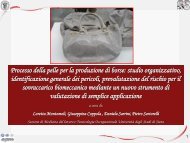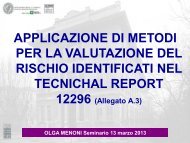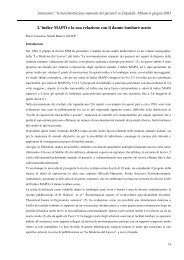Ocra method a new procedure for analysing multiple repetitive tasks
Ocra method: a new procedure for analysing multiple ... - epm
Ocra method: a new procedure for analysing multiple ... - epm
Create successful ePaper yourself
Turn your PDF publications into a flip-book with our unique Google optimized e-Paper software.
In addition, to describe the intrinsic time distribution of the<strong>tasks</strong> presented in Table 4, it is necessary to reassess theproportion by weighting them on “worked time constants”.Table 5 shows the generic reference working durationconstants expressed in hours/month (160), days/month (20),days/year (220), months work/year (11), worked hours/year(1760)Worked hours/ month constant 160 Working month constant 11Worked days/ month constant 20.0 Working hour/ year constant 1760Worked days/ year constant 220Table 5 - Duration constants of generic working activity tobe used to weight exposure duration.Starting (with reference to) from the constants reported inTable 5, we can calculate the weighted proportionaldistribution among the <strong>tasks</strong> developed in the year.The example reported in Table 6 sows this passage: the totaloriginal (from table 4) worked hours/year is 1680: consideringthat the constant used is equal to 1760 hours (table 5), there isa 0.5% reduction of working activity. The result is that thepercentages reported in the column of “weighted proportionaldistribution” (respect to the constant) are lower that those ofintrinsic proportional distribution. If by contrast, the total ofworked hours exceeds the constant, the % reported in thecolumn of calibrated proportional distribution will be higher.WORKING TASKSGENFEBMARAPRMAYJUNELJULYAUGUSEPTOCTNOVDECTOT.WORKEDHOURSINTRINSIC%1680 100,0% 95,5%A 50% 100% 100% 340 20,2% 19,3%B 100% 100% 50% 440 26,2% 25,0%C 100% 200 11,9% 11,4%D 100% 200 11,9% 11,4%E 100% 50% 240 14,3% 13,6%F 50% 44% 160 9,5% 9,1%G 56% 100% 100 6,0% 5,7%CONSTANTWEIGHTED%Table 6 - Example of calculation of weighted proportional distribution (considering the constant) among the <strong>tasks</strong> carriedout in the year and as compared with intrinsic proportional distribution (worked out from Table 3).THE OCRA METHOD FOR DAILY ROTATING TASKSOCRA checklist <strong>for</strong> assessment of “intrinsic level” ofexposureThe OCRA <strong>method</strong> (Occhipinti, 1998 ; Colombini et al.2002), now adopted by ISO (ISO 12228-3) and CEN(EN1005-5) standards suggests to identify and quantify thefollowing main risk factors which characterise a work-relatedexposure to <strong>repetitive</strong> <strong>tasks</strong>. They are: frequency of highaction, excessive use of <strong>for</strong>ce, awkward and/or stereotypedupper limb movements and postures, lack of appropriaterecovery periods, additional risk factors, net duration of the<strong>repetitive</strong> task(s).The OCRA <strong>method</strong> proposes two risk analysis tools: OCRAindex and OCRA checklist.OCRA checklistscoreUp to 7.57.6 – 11.011.1 – 14.014.1 – 22.5≥ 22.6OCRA indexscore2.22.3 – 3.53.6 – 4.54.6 – 9.0≥ 9.1Exposure levelsGREENYELLOWRED LIGHTRED MEDIUMRED HIGH= No risk= borderline= light risk= medium risk= high riskTable 7- The final score of OCRA checklist matched withOCRA index score and related risk ranges.After tackling the first organizational study stage(identification of developed <strong>tasks</strong> and turnover times, timeproportion in the final cyclic period, shift net duration andbreak distribution), the study aimed at obtaining final exposureOCRA checklist, is the priority analytical model bothduring the first risk assessment stage in a given workingsituation (mapping stage). Like OCRA index, the OCRAchecklist consists of 5 parts dedicated to the study of the fourmain risk factors (lack of recovery periods, frequency, <strong>for</strong>ce,awkward postures and stereotypy) and additional factors(vibrations, extreme cold temperatures, countershocks, etc.).The analytical scheme proposed by OCRA checklistidentifies pre-established numerical values (increasing versusrisk increase) <strong>for</strong> each of the 4 main risk factors and <strong>for</strong>additional factors.The sum of the obtained partial values produces a numericalfigure (score) allowing to assess the exposure level through arelationship with OCRA index values in a variety of ranges(green, yellow, red, purple), as described in Table 7.levels needs research of intrinsic OCRA checklist final valueof each identified task.When speaking of intrinsic value, we mean assessing eachtask as if it was the only task developed along the whole shift(approx 440 net minutes of <strong>repetitive</strong> task duration with alunch break of at least 30 minutes and two breaks of minimum8 minutes).Table 8 reports the examples of risk assessment withchecklist on a group of <strong>tasks</strong> developed in one year.Assessments are to be referred to one limb (in this case theright one) maintaining the score of each risk factor. The finalscore expresses the value of intrinsic index.




